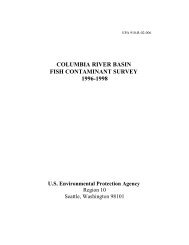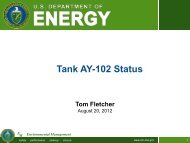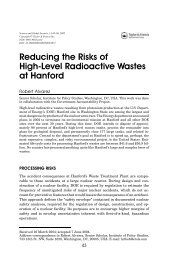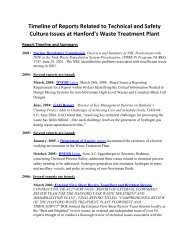Knowing Endangerment - Hanford Challenge
Knowing Endangerment - Hanford Challenge
Knowing Endangerment - Hanford Challenge
You also want an ePaper? Increase the reach of your titles
YUMPU automatically turns print PDFs into web optimized ePapers that Google loves.
vapor sources. Initially, we were told by the on-call IH to wear air purifying<br />
respirators, but operations was unable to obtain these items for us and we were told to<br />
wear nuisance masks instead. Nuisance masks are available to anyone who wants<br />
them any day to keep out annoying odors and are not considered PPE. They should<br />
not be used when responding to abnormal conditions. Considering the press the site<br />
has received in recent days concerning hazardous vapors, the PERCEPTION in this<br />
situation is horrifying. We were told that the nuisance mask was just that and not for<br />
personal protection. If there was no hazard then what were we looking for and why<br />
was a man in the hospital? 80<br />
GAP has found several instances of workers wearing dust masks in conditions which resulted in the<br />
need for medical attention. 81 Additionally, GAP has found several instances where workers were in<br />
environments with very high concentrations of contaminants with no respiratory protection<br />
whatsoever. 82 In fact, the overwhelming majority of the 120 chemical vapor exposures and odor<br />
reports between January 2002 and August 2003 involved tank farm workers who were not wearing<br />
any respiratory protection. GAP has determined that there are several reasons why this is occurring.<br />
First and foremost, CHG is overly-dependent on inadequate monitoring equipment for making<br />
respiratory protection decisions. Even while recognizing that there are “unknown chemical<br />
constituents and compounds” emitting from the tanks that cannot be tested with CHG‟s current air<br />
monitoring equipment, 83 CHG does not consider the working conditions to be unknown or<br />
uncharacterized. CHG instead relies upon its monitoring equipment and methodology to identify job<br />
hazards and determine whether respiratory protection should be used. Despite recurring health<br />
symptoms indicating that workers are being exposed to significant contaminant levels, CHG still<br />
relies on the readings from this monitoring equipment to argue that workers are not being exposed to<br />
dangerous levels.<br />
Second, even when the monitoring equipment measures contaminants in excess of 25 ppm,<br />
respiratory protection often is not required because of a loophole in the safety plan:<br />
80 PER-2003-3194, Aug. 17, 2003.<br />
81 PER-2003-0498, Feb. 3, 2003 (2 workers near AW exhauster pad smelled organic smell that did not register on<br />
meter, then developed burning tongue and lips, lightheadedness, and battery acid taste in mouth. One worker was<br />
transported to Kadlec hospital. IH recommendations for entry into area after the fact were: “All personnel entering<br />
241-AW shall have a 3M 8577 nuisance mask available and ready to don if any vapors not normal are detected.”);<br />
CHG, IH DRI Survey, ID # 03-0197, Feb. 11, 2003 and HEHF Medical Record obtained through FOIA (At C-103,<br />
ammonia concentrations were 300ppm at the source of the pump pit and 0-20 ppm in the area. “Some workers wore<br />
paper type odor mask during work.” One of the workers wearing dust mask reported to HEHF the following day.);<br />
HEHF Medical Records obtained through FOIA, July 1, 2003 (NCO and co-worker smelled strong vapor odor<br />
intermittently. They obtained a dust-type mask with charcoal filter, but could still smell the odor. Both reported to<br />
HEHF complaining of scratchy throats).<br />
82 CHG, IH DRI Survey ID # 03-0076, Jan. 16, 2003 (Area level readings detected ammonia at 50ppm, TOC at<br />
7101ppb, no PPE was worn.); CHG, IH DRI Survey ID # 03-0294 and Air Sampling Summary 03-0294, Feb. 9,<br />
2003 (Area levels readings detected ammonia at 58ppm and TOC at 2.3ppm. PPE was not worn.); CHG, IH DRI<br />
Survey ID # 03-0186 and Air Sampling Summary 03-0186, Feb. 10, 2003 (Area level TOC reached 20ppm, source<br />
TOC readings reached 87ppm, and no PPE was worn.); CHG, IH DRI Survey ID # 03-0324 and Air Sampling<br />
Summary 03-0324, Feb. 21, 2003 (Area level TOC detected at 1.5-2.5 ppm with a “strong musty odor,” No PPE<br />
was worn.).<br />
83 Stated by a senior Industrial Hygienist for CHG. IH Deposition, supra note 49, at 62.<br />
20







